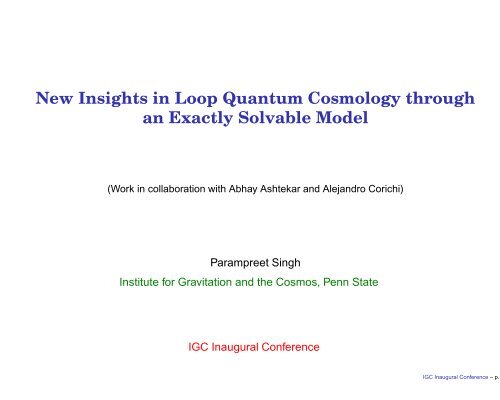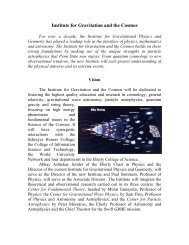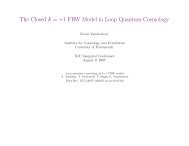Contrasting LQC and WDW Theory Using an Exactly Solvable Model
Contrasting LQC and WDW Theory Using an Exactly Solvable Model
Contrasting LQC and WDW Theory Using an Exactly Solvable Model
You also want an ePaper? Increase the reach of your titles
YUMPU automatically turns print PDFs into web optimized ePapers that Google loves.
New Insights in Loop Qu<strong>an</strong>tum Cosmology through<br />
<strong>an</strong> <strong>Exactly</strong> <strong>Solvable</strong> <strong>Model</strong><br />
(Work in collaboration with Abhay Ashtekar <strong><strong>an</strong>d</strong> Alej<strong><strong>an</strong>d</strong>ro Corichi)<br />
Parampreet Singh<br />
Institute for Gravitation <strong><strong>an</strong>d</strong> the Cosmos, Penn State<br />
IGC Inaugural Conference<br />
IGC Inaugural Conference – p.1
Motivation<br />
Extensive <strong>an</strong>alytical <strong><strong>an</strong>d</strong> numerical methods in <strong>LQC</strong>: valuable insights<br />
on singularity resolution in symmetry reduced models.<br />
(Ashtekar, Pawlowski, PS (06-) + V<strong><strong>an</strong>d</strong>ersloot (07))<br />
IGC Inaugural Conference – p.2
Motivation<br />
Extensive <strong>an</strong>alytical <strong><strong>an</strong>d</strong> numerical methods in <strong>LQC</strong>: valuable insights<br />
on singularity resolution in symmetry reduced models.<br />
(Ashtekar, Pawlowski, PS (06-) + V<strong><strong>an</strong>d</strong>ersloot (07))<br />
Consider a semi-classical state in a large universe at low curvature<br />
<strong><strong>an</strong>d</strong> evolve backward towards big b<strong>an</strong>g. State follows classical<br />
trajectory till it reaches close to Pl<strong>an</strong>ck scale. Does not fall into<br />
singularity, but bounces in Pl<strong>an</strong>ck regime to a pre-big b<strong>an</strong>g br<strong>an</strong>ch.<br />
IGC Inaugural Conference – p.2
Motivation<br />
Extensive <strong>an</strong>alytical <strong><strong>an</strong>d</strong> numerical methods in <strong>LQC</strong>: valuable insights<br />
on singularity resolution in symmetry reduced models.<br />
(Ashtekar, Pawlowski, PS (06-) + V<strong><strong>an</strong>d</strong>ersloot (07))<br />
Consider a semi-classical state in a large universe at low curvature<br />
<strong><strong>an</strong>d</strong> evolve backward towards big b<strong>an</strong>g. State follows classical<br />
trajectory till it reaches close to Pl<strong>an</strong>ck scale. Does not fall into<br />
singularity, but bounces in Pl<strong>an</strong>ck regime to a pre-big b<strong>an</strong>g br<strong>an</strong>ch.<br />
Underlying discrete qu<strong>an</strong>tum geometry leads to repulsive QG<br />
effects at Pl<strong>an</strong>ck scale. Classical Big B<strong>an</strong>g replaced by Qu<strong>an</strong>tum Big<br />
Bounce.<br />
IGC Inaugural Conference – p.2
Motivation<br />
Extensive <strong>an</strong>alytical <strong><strong>an</strong>d</strong> numerical methods in <strong>LQC</strong>: valuable insights<br />
on singularity resolution in symmetry reduced models.<br />
(Ashtekar, Pawlowski, PS (06-) + V<strong><strong>an</strong>d</strong>ersloot (07))<br />
Consider a semi-classical state in a large universe at low curvature<br />
<strong><strong>an</strong>d</strong> evolve backward towards big b<strong>an</strong>g. State follows classical<br />
trajectory till it reaches close to Pl<strong>an</strong>ck scale. Does not fall into<br />
singularity, but bounces in Pl<strong>an</strong>ck regime to a pre-big b<strong>an</strong>g br<strong>an</strong>ch.<br />
Underlying discrete qu<strong>an</strong>tum geometry leads to repulsive QG<br />
effects at Pl<strong>an</strong>ck scale. Classical Big B<strong>an</strong>g replaced by Qu<strong>an</strong>tum Big<br />
Bounce.<br />
Some open questions:<br />
IGC Inaugural Conference – p.2
Motivation<br />
Extensive <strong>an</strong>alytical <strong><strong>an</strong>d</strong> numerical methods in <strong>LQC</strong>: valuable insights<br />
on singularity resolution in symmetry reduced models.<br />
(Ashtekar, Pawlowski, PS (06-) + V<strong><strong>an</strong>d</strong>ersloot (07))<br />
Consider a semi-classical state in a large universe at low curvature<br />
<strong><strong>an</strong>d</strong> evolve backward towards big b<strong>an</strong>g. State follows classical<br />
trajectory till it reaches close to Pl<strong>an</strong>ck scale. Does not fall into<br />
singularity, but bounces in Pl<strong>an</strong>ck regime to a pre-big b<strong>an</strong>g br<strong>an</strong>ch.<br />
Underlying discrete qu<strong>an</strong>tum geometry leads to repulsive QG<br />
effects at Pl<strong>an</strong>ck scale. Classical Big B<strong>an</strong>g replaced by Qu<strong>an</strong>tum Big<br />
Bounce.<br />
Some open questions:<br />
Is bounce restricted only to the states which are semi-classical at<br />
late times?<br />
IGC Inaugural Conference – p.2
Motivation<br />
Extensive <strong>an</strong>alytical <strong><strong>an</strong>d</strong> numerical methods in <strong>LQC</strong>: valuable insights<br />
on singularity resolution in symmetry reduced models.<br />
(Ashtekar, Pawlowski, PS (06-) + V<strong><strong>an</strong>d</strong>ersloot (07))<br />
Consider a semi-classical state in a large universe at low curvature<br />
<strong><strong>an</strong>d</strong> evolve backward towards big b<strong>an</strong>g. State follows classical<br />
trajectory till it reaches close to Pl<strong>an</strong>ck scale. Does not fall into<br />
singularity, but bounces in Pl<strong>an</strong>ck regime to a pre-big b<strong>an</strong>g br<strong>an</strong>ch.<br />
Underlying discrete qu<strong>an</strong>tum geometry leads to repulsive QG<br />
effects at Pl<strong>an</strong>ck scale. Classical Big B<strong>an</strong>g replaced by Qu<strong>an</strong>tum Big<br />
Bounce.<br />
Some open questions:<br />
Is bounce restricted only to the states which are semi-classical at<br />
late times?<br />
What happens to the fluctuations in general? Does universe retain<br />
its memory through the bounce?<br />
IGC Inaugural Conference – p.2
Motivation<br />
Extensive <strong>an</strong>alytical <strong><strong>an</strong>d</strong> numerical methods in <strong>LQC</strong>: valuable insights<br />
on singularity resolution in symmetry reduced models.<br />
(Ashtekar, Pawlowski, PS (06-) + V<strong><strong>an</strong>d</strong>ersloot (07))<br />
Consider a semi-classical state in a large universe at low curvature<br />
<strong><strong>an</strong>d</strong> evolve backward towards big b<strong>an</strong>g. State follows classical<br />
trajectory till it reaches close to Pl<strong>an</strong>ck scale. Does not fall into<br />
singularity, but bounces in Pl<strong>an</strong>ck regime to a pre-big b<strong>an</strong>g br<strong>an</strong>ch.<br />
Underlying discrete qu<strong>an</strong>tum geometry leads to repulsive QG<br />
effects at Pl<strong>an</strong>ck scale. Classical Big B<strong>an</strong>g replaced by Qu<strong>an</strong>tum Big<br />
Bounce.<br />
Some open questions:<br />
Is bounce restricted only to the states which are semi-classical at<br />
late times?<br />
What happens to the fluctuations in general? Does universe retain<br />
its memory through the bounce?<br />
In what sense <strong>LQC</strong> <strong><strong>an</strong>d</strong> <strong>WDW</strong> converge to each other or diverge<br />
from each other?<br />
IGC Inaugural Conference – p.2
Motivation<br />
Extensive <strong>an</strong>alytical <strong><strong>an</strong>d</strong> numerical methods in <strong>LQC</strong>: valuable insights<br />
on singularity resolution in symmetry reduced models.<br />
(Ashtekar, Pawlowski, PS (06-) + V<strong><strong>an</strong>d</strong>ersloot (07))<br />
Consider a semi-classical state in a large universe at low curvature<br />
<strong><strong>an</strong>d</strong> evolve backward towards big b<strong>an</strong>g. State follows classical<br />
trajectory till it reaches close to Pl<strong>an</strong>ck scale. Does not fall into<br />
singularity, but bounces in Pl<strong>an</strong>ck regime to a pre-big b<strong>an</strong>g br<strong>an</strong>ch.<br />
Underlying discrete qu<strong>an</strong>tum geometry leads to repulsive QG<br />
effects at Pl<strong>an</strong>ck scale. Classical Big B<strong>an</strong>g replaced by Qu<strong>an</strong>tum Big<br />
Bounce.<br />
Some open questions:<br />
Is bounce restricted only to the states which are semi-classical at<br />
late times?<br />
What happens to the fluctuations in general? Does universe retain<br />
its memory through the bounce?<br />
In what sense <strong>LQC</strong> <strong><strong>an</strong>d</strong> <strong>WDW</strong> converge to each other or diverge<br />
from each other?<br />
Does <strong>LQC</strong> have a qu<strong>an</strong>tum continuum limit?<br />
IGC Inaugural Conference – p.2
<strong>Exactly</strong> <strong>Solvable</strong> <strong>LQC</strong> (S<strong>LQC</strong>)<br />
C<strong>an</strong>onical qu<strong>an</strong>tization of homogeneous <strong><strong>an</strong>d</strong> isotropic cosmology<br />
based on LQG.<br />
Homogeneity <strong><strong>an</strong>d</strong> Isotropy ⇒ A i a −→ c, E a i<br />
Relation with metric variables: |p| = a 2 , c ∝ ˙a<br />
Full control on qu<strong>an</strong>tum theory for various models.<br />
Qu<strong>an</strong>tum constraint with massless scalar:<br />
Θ(v)Ψ(v, φ) = −∂ 2 φ Ψ(v, φ)<br />
−→ p<br />
Uniform difference equation in v with a correct classical limit, no<br />
gauge artificats <strong><strong>an</strong>d</strong> no fake Pl<strong>an</strong>ck scale effects. (Contrast with early<br />
models, other discretization schemes).<br />
→ v = |p| 3/2 /(2πγℓ 2 P ), b := c/|p|1/2 , {b, v} = 2<br />
Qu<strong>an</strong>tum Constraint inbrepresentation:<br />
Θ(b)χ(b, φ) = −12πG sin(λb)<br />
λ<br />
∂<br />
∂b<br />
sin(λb)<br />
λ<br />
∂<br />
∂b χ(b, φ) = − ∂2 φ χ(b, φ)<br />
φ → internal time. Θ: positive definite & self adjoint. λ 2 → Area Gap<br />
IGC Inaugural Conference – p.3
Hilbert space c<strong>an</strong> be constructed following Klein-Gordon theory<br />
(Positive frequency solutions).<br />
Physical Inner product:<br />
(χ, χ)phy =<br />
Dirac Observables: ˆPφ, ˆV |φ<br />
Introduce x := (12πG) −1/2 ln(t<strong>an</strong>(λb/2))<br />
<br />
db ¯χ(b)|ˆv|χ(b)<br />
Qu<strong>an</strong>tum Constraint: ∂ 2 φ χ(φ, x) = ∂2 x χ(φ, x)<br />
General solution:<br />
χ = χ+(φ + x) + χ−(φ − x) := χ+(x+) + χ−(x−)<br />
Physical states <strong>an</strong>ti-symmetric inb: χ(b, φ) = −χ(b − π/2, φ). Imposes<br />
relation between χ+ <strong><strong>an</strong>d</strong> χ−<br />
IGC Inaugural Conference – p.4
Wheeler-DeWitt <strong>Theory</strong><br />
Qu<strong>an</strong>tum constraint inbrepresentation:<br />
Θ(b)χ(b, φ) = −12πG b ∂<br />
∂b<br />
b ∂<br />
∂b χ(b, φ) = −∂2 φχ(b, φ)<br />
As in S<strong>LQC</strong>, we have <strong>an</strong> internal clock, physical inner product <strong><strong>an</strong>d</strong><br />
Dirac Obsevables.<br />
Introduce<br />
⇒<br />
General solution:<br />
y := (12πG) −1/2 ln (b/2bo)<br />
∂ 2 φχ(φ, y) = ∂ 2 yχ(φ, y)<br />
χ = χ+(φ + y) + χ−(φ − y) := χ+(y+) + χ−(y−)<br />
Unlike S<strong>LQC</strong>, χ+ (exp<strong><strong>an</strong>d</strong>ing) <strong><strong>an</strong>d</strong> χ− (contracting) are disjoint.<br />
IGC Inaugural Conference – p.5
Volume observable in <strong>WDW</strong><br />
(χ, ˆ V |φ χ)phy = 2πγℓ 2 P (ˆvχ, ˆvχ)kin<br />
=<br />
16γℓ 2 P<br />
√ 12πGb 2 o<br />
√<br />
12πGφ<br />
= Vo e .<br />
∞<br />
−∞<br />
dy+<br />
<br />
dχ+<br />
<br />
<br />
dy+<br />
<br />
2<br />
√<br />
12πG(φ−y+)<br />
e<br />
As φ → −∞, 〈 ˆ V |φ〉 → 0. The backward evolution leads to the big b<strong>an</strong>g<br />
singularity.<br />
Fluctuations:<br />
(χ, ˆ V 2 |φ χ)phy = W0 e 2√ 12πGφ<br />
((∆V |φ)/〈ˆV |φ〉) 2 = (W0/V0) 2 − 1 .<br />
Remains const<strong>an</strong>t with evolution.<br />
IGC Inaugural Conference – p.6
Volume observable in S<strong>LQC</strong><br />
(χ, ˆ V |φ χ)phy = 8γℓ2 P λ2<br />
√ 12πG<br />
∞<br />
+<br />
∞<br />
dx−<br />
−∞<br />
dx+<br />
<br />
dχ−<br />
<br />
<br />
dx−<br />
<br />
−∞<br />
= I+ e −√ √<br />
12πGφ 12πGφ<br />
+ I− e<br />
2<br />
<br />
dχ+<br />
2<br />
<br />
dx+<br />
cosh( √ 12πG(x+ − φ))<br />
cosh( √ <br />
12πG(−x− + φ))<br />
There exists a minimum value of 〈V | (φ=φB)〉 which occurs at<br />
φB = (2 √ 12πG) −1 ln(I+/I−)<br />
〈V |φ〉 is symmetric across the bounce point.<br />
IGC Inaugural Conference – p.7
Fluctuations<br />
〈V 2 |φ〉 = J0 + J+e −2√ 12πGφ + J−e 2√ 12πGφ<br />
is symmetric across<br />
Relative dispersion:<br />
φ ′ B = (4 √ 12πG) −1 ln(J+/J−)<br />
(∆V/〈 ˆ V 〉) 2 φ→∞ = J−<br />
I 2 −<br />
(∆V/〈 ˆ V 〉) 2 φ→−∞ = J+<br />
I 2 +<br />
− 1<br />
− 1<br />
For φB = φ ′ B , D := (∆V/〈ˆ V 〉) 2 φ→−∞ − (∆V/〈ˆ V 〉) 2 φ→∞<br />
= 0<br />
Relative dispersion bounded in time evolution. A single condition on<br />
the infinite dimensional space of initial data implies symmetric<br />
fluctuations across bounce point.<br />
IGC Inaugural Conference – p.8
How much does the Cosmos recall?<br />
For a very large class of states universe retains all its memory across<br />
the bounce:<br />
∞<br />
χ(x, φ) = dk ˜F(k) e −ik(φ+x) ∞<br />
− dk ˜F(k) e −ik(φ−x)<br />
0<br />
For <strong>an</strong>y real <strong><strong>an</strong>d</strong> arbitrary ˜ F(k), fluctuations are symmetric.<br />
0<br />
IGC Inaugural Conference – p.9
How much does the Cosmos recall?<br />
For a very large class of states universe retains all its memory across<br />
the bounce:<br />
∞<br />
χ(x, φ) = dk ˜F(k) e −ik(φ+x) ∞<br />
− dk ˜F(k) e −ik(φ−x)<br />
0<br />
For <strong>an</strong>y real <strong><strong>an</strong>d</strong> arbitrary ˜ F(k), fluctuations are symmetric.<br />
Includes real linear combinations of<br />
fn(k) = k n e −(k−k0) 2 /β 2 +ik x0 ,<br />
→ includes all squeezed states with arbitrary squeezing.<br />
0<br />
IGC Inaugural Conference – p.9
How much does the Cosmos recall?<br />
For a very large class of states universe retains all its memory across<br />
the bounce:<br />
∞<br />
χ(x, φ) = dk ˜F(k) e −ik(φ+x) ∞<br />
− dk ˜F(k) e −ik(φ−x)<br />
0<br />
For <strong>an</strong>y real <strong><strong>an</strong>d</strong> arbitrary ˜ F(k), fluctuations are symmetric.<br />
Includes real linear combinations of<br />
fn(k) = k n e −(k−k0) 2 /β 2 +ik x0 ,<br />
→ includes all squeezed states with arbitrary squeezing.<br />
Cosmos remembers everything across the bounce for such states.<br />
There is a Total Recall.<br />
0<br />
IGC Inaugural Conference – p.9
How much does the Cosmos recall?<br />
Consider a general state in the present epoch (post big b<strong>an</strong>g)<br />
describing a large classical universe at low curvature<br />
lim<br />
φ→∞<br />
<br />
(∆ˆV )<br />
〈 ˆ V 〉<br />
2<br />
Relative dispersion in curvature:<br />
= J−<br />
I 2 −<br />
− 1 =: δv ≪ 1<br />
(∆t<strong>an</strong>(λb/2)/〈t<strong>an</strong>(λb/2)〉) = √ 12πG∆x =: δb ≪ 1<br />
IGC Inaugural Conference – p.10
How much does the Cosmos recall?<br />
Consider a general state in the present epoch (post big b<strong>an</strong>g)<br />
describing a large classical universe at low curvature<br />
lim<br />
φ→∞<br />
<br />
(∆ˆV )<br />
〈 ˆ V 〉<br />
2<br />
Relative dispersion in curvature:<br />
= J−<br />
I 2 −<br />
− 1 =: δv ≪ 1<br />
(∆t<strong>an</strong>(λb/2)/〈t<strong>an</strong>(λb/2)〉) = √ 12πG∆x =: δb ≪ 1<br />
D = (∆V/〈ˆV 〉) 2 φ→−∞ − (∆V/〈ˆV 〉) 2 φ→∞<br />
< (1 + δv) (e 8δb − 1)<br />
IGC Inaugural Conference – p.10
How much does the Cosmos recall?<br />
Consider a general state in the present epoch (post big b<strong>an</strong>g)<br />
describing a large classical universe at low curvature<br />
lim<br />
φ→∞<br />
<br />
(∆ˆV )<br />
〈 ˆ V 〉<br />
2<br />
Relative dispersion in curvature:<br />
= J−<br />
I 2 −<br />
− 1 =: δv ≪ 1<br />
(∆t<strong>an</strong>(λb/2)/〈t<strong>an</strong>(λb/2)〉) = √ 12πG∆x =: δb ≪ 1<br />
D = (∆V/〈ˆV 〉) 2 φ→−∞ − (∆V/〈ˆV 〉) 2 φ→∞<br />
< (1 + δv) (e 8δb − 1)<br />
Difference bounded by the relative dispersions in the initial state. A<br />
semi-classical initial state evolves to a semi-classical state after the<br />
bounce. Fluctuations are symmetric up to very small difference.<br />
IGC Inaugural Conference – p.10
How much does the Cosmos recall?<br />
Consider a general state in the present epoch (post big b<strong>an</strong>g)<br />
describing a large classical universe at low curvature<br />
lim<br />
φ→∞<br />
<br />
(∆ˆV )<br />
〈 ˆ V 〉<br />
2<br />
Relative dispersion in curvature:<br />
= J−<br />
I 2 −<br />
− 1 =: δv ≪ 1<br />
(∆t<strong>an</strong>(λb/2)/〈t<strong>an</strong>(λb/2)〉) = √ 12πG∆x =: δb ≪ 1<br />
D = (∆V/〈ˆV 〉) 2 φ→−∞ − (∆V/〈ˆV 〉) 2 φ→∞<br />
< (1 + δv) (e 8δb − 1)<br />
Difference bounded by the relative dispersions in the initial state. A<br />
semi-classical initial state evolves to a semi-classical state after the<br />
bounce. Fluctuations are symmetric up to very small difference.<br />
Answer: Universe has a very very sharp memory.<br />
Cosmos remembers almost everything after the bounce.<br />
IGC Inaugural Conference – p.10
<strong>WDW</strong> & S<strong>LQC</strong> <strong><strong>an</strong>d</strong> the lack of continuum limit<br />
For a fixed value of λ select Ψ0(b):〈ˆV |φ=0〉λ = 〈ˆV |φ=0〉<strong>WDW</strong> =: V0<br />
Relative difference: bounded in future evolution<br />
|〈 ˆ V 〉<strong>WDW</strong>(φ) − 〈 ˆ V 〉λ(φ)|/〈 ˆ V 〉<strong>WDW</strong>(φ) ≤ δ := I1/V0 (very small)<br />
IGC Inaugural Conference – p.11
<strong>WDW</strong> & S<strong>LQC</strong> <strong><strong>an</strong>d</strong> the lack of continuum limit<br />
For a fixed value of λ select Ψ0(b):〈ˆV |φ=0〉λ = 〈ˆV |φ=0〉<strong>WDW</strong> =: V0<br />
Relative difference: bounded in future evolution<br />
|〈 ˆ V 〉<strong>WDW</strong>(φ) − 〈 ˆ V 〉λ(φ)|/〈 ˆ V 〉<strong>WDW</strong>(φ) ≤ δ := I1/V0 (very small)<br />
For a given φT <strong><strong>an</strong>d</strong> ǫ > 0, ∃ λ (ǫ,T) > 0 such that,<br />
|〈ˆV 〉<strong>WDW</strong>(φ) − 〈ˆV 〉λ(φ)| < ǫ<br />
IGC Inaugural Conference – p.11
<strong>WDW</strong> & S<strong>LQC</strong> <strong><strong>an</strong>d</strong> the lack of continuum limit<br />
For a fixed value of λ select Ψ0(b):〈ˆV |φ=0〉λ = 〈ˆV |φ=0〉<strong>WDW</strong> =: V0<br />
Relative difference: bounded in future evolution<br />
|〈 ˆ V 〉<strong>WDW</strong>(φ) − 〈 ˆ V 〉λ(φ)|/〈 ˆ V 〉<strong>WDW</strong>(φ) ≤ δ := I1/V0 (very small)<br />
For a given φT <strong><strong>an</strong>d</strong> ǫ > 0, ∃ λ (ǫ,T) > 0 such that,<br />
|〈ˆV 〉<strong>WDW</strong>(φ) − 〈ˆV 〉λ(φ)| < ǫ<br />
For <strong>an</strong>y N > 0 (arbitrarily large) ∃ φ such that<br />
|〈 ˆ V 〉<strong>WDW</strong>(φ) − 〈 ˆ V 〉λ(φ)| > N<br />
IGC Inaugural Conference – p.11
<strong>WDW</strong> & S<strong>LQC</strong> <strong><strong>an</strong>d</strong> the lack of continuum limit<br />
For a fixed value of λ select Ψ0(b):〈ˆV |φ=0〉λ = 〈ˆV |φ=0〉<strong>WDW</strong> =: V0<br />
Relative difference: bounded in future evolution<br />
|〈 ˆ V 〉<strong>WDW</strong>(φ) − 〈 ˆ V 〉λ(φ)|/〈 ˆ V 〉<strong>WDW</strong>(φ) ≤ δ := I1/V0 (very small)<br />
For a given φT <strong><strong>an</strong>d</strong> ǫ > 0, ∃ λ (ǫ,T) > 0 such that,<br />
|〈ˆV 〉<strong>WDW</strong>(φ) − 〈ˆV 〉λ(φ)| < ǫ<br />
For <strong>an</strong>y N > 0 (arbitrarily large) ∃ φ such that<br />
|〈 ˆ V 〉<strong>WDW</strong>(φ) − 〈 ˆ V 〉λ(φ)| > N<br />
Is there a qu<strong>an</strong>tum continuum limit of S<strong>LQC</strong>?<br />
Consider backward evolution: 〈 ˆ V 〉λo − 〈 ˆ V 〉λ diverges as φ → −∞.<br />
φB −→ −∞ as λ → 0.<br />
→ Uniform limit does not exist.<br />
Contrast with results on Harmonic Oscillator (Corichi, Vukasinac, Zapata (07)).<br />
IGC Inaugural Conference – p.11
Summary<br />
Bounce not restricted to states which are semi-classical at late times.<br />
There is a pre-big b<strong>an</strong>g br<strong>an</strong>ch for a dense subspace of Hphy.<br />
For a very large class of states fluctuations are exactly symmetric<br />
across the bounce. More general states which describe a large volume<br />
low curvature epoch, fluctuations are symmetric up to negligible<br />
difference. Universe retains almost all its memory across bounce.<br />
(Results in harmony with various numerical simulations).<br />
S<strong>LQC</strong> <strong><strong>an</strong>d</strong> <strong>WDW</strong> approach GR at low curvatures. At large curvatures<br />
they depart signific<strong>an</strong>tly.<br />
In the backward evolution of the exp<strong><strong>an</strong>d</strong>ing br<strong>an</strong>ch for <strong>an</strong>y given<br />
fixed time interval, S<strong>LQC</strong> <strong><strong>an</strong>d</strong> <strong>WDW</strong> agree to arbitrary accuracy by a<br />
choice of λ. However, for <strong>an</strong>y given choice of λ, they diverge if one<br />
waits long enough.<br />
There is no limiting theory of S<strong>LQC</strong> when λ → 0. Two different λ<br />
S<strong>LQC</strong>’s depart in a similar way as they do from <strong>WDW</strong>. S<strong>LQC</strong> is a<br />
fundamentally discrete theory.<br />
IGC Inaugural Conference – p.12
Fundamental discreteness of S<strong>LQC</strong><br />
Start with <strong>an</strong> arbitrary λo, refine the area gap (λo → λ).<br />
For λ < λo, χi ∈ Hλo under embedding χi ∈ Hλ.<br />
Under renormalization χ λ := λo/λ χ λo , |χ λ | 2 = |χ λo | 2 .<br />
IGC Inaugural Conference – p.13
Fundamental discreteness of S<strong>LQC</strong><br />
Start with <strong>an</strong> arbitrary λo, refine the area gap (λo → λ).<br />
For λ < λo, χi ∈ Hλo under embedding χi ∈ Hλ.<br />
Under renormalization χ λ := λo/λ χ λo , |χ λ | 2 = |χ λo | 2 .<br />
Initial data: At φ = φi, χ λ i<br />
<strong><strong>an</strong>d</strong> χλo<br />
i give same 〈ˆ V 〉.<br />
IGC Inaugural Conference – p.13
Fundamental discreteness of S<strong>LQC</strong><br />
Start with <strong>an</strong> arbitrary λo, refine the area gap (λo → λ).<br />
For λ < λo, χi ∈ Hλo under embedding χi ∈ Hλ.<br />
Under renormalization χ λ := λo/λ χ λo , |χ λ | 2 = |χ λo | 2 .<br />
Initial data: At φ = φi, χ λ i<br />
<strong><strong>an</strong>d</strong> χλo<br />
i give same 〈ˆ V 〉.<br />
Refinement in λ ⇒ xλ = xλo ⇒ I+,−(λ) = I+,−(λo). I−(λ) is a<br />
monotonic decreasing function. As λ → 0, I−(λ) grows.<br />
IGC Inaugural Conference – p.13
Fundamental discreteness of S<strong>LQC</strong><br />
Start with <strong>an</strong> arbitrary λo, refine the area gap (λo → λ).<br />
For λ < λo, χi ∈ Hλo under embedding χi ∈ Hλ.<br />
Under renormalization χ λ := λo/λ χ λo , |χ λ | 2 = |χ λo | 2 .<br />
Initial data: At φ = φi, χ λ i<br />
<strong><strong>an</strong>d</strong> χλo<br />
i give same 〈ˆ V 〉.<br />
Refinement in λ ⇒ xλ = xλo ⇒ I+,−(λ) = I+,−(λo). I−(λ) is a<br />
monotonic decreasing function. As λ → 0, I−(λ) grows.<br />
Consequence: In the backward evolution of <strong>an</strong> exp<strong><strong>an</strong>d</strong>ing br<strong>an</strong>ch<br />
〈ˆV 〉λo − 〈ˆV 〉λ = (I−(λo) − I−(λ))e −√ 12πG φ<br />
which diverges as φ → −∞.<br />
φB = (2 √ 12πG) −1 ln(I+/I−) −→ −∞ as λ → 0.<br />
IGC Inaugural Conference – p.13
Fundamental discreteness of S<strong>LQC</strong><br />
Start with <strong>an</strong> arbitrary λo, refine the area gap (λo → λ).<br />
For λ < λo, χi ∈ Hλo under embedding χi ∈ Hλ.<br />
Under renormalization χ λ := λo/λ χ λo , |χ λ | 2 = |χ λo | 2 .<br />
Initial data: At φ = φi, χ λ i<br />
<strong><strong>an</strong>d</strong> χλo<br />
i give same 〈ˆ V 〉.<br />
Refinement in λ ⇒ xλ = xλo ⇒ I+,−(λ) = I+,−(λo). I−(λ) is a<br />
monotonic decreasing function. As λ → 0, I−(λ) grows.<br />
Consequence: In the backward evolution of <strong>an</strong> exp<strong><strong>an</strong>d</strong>ing br<strong>an</strong>ch<br />
〈ˆV 〉λo − 〈ˆV 〉λ = (I−(λo) − I−(λ))e −√ 12πG φ<br />
which diverges as φ → −∞.<br />
φB = (2 √ 12πG) −1 ln(I+/I−) −→ −∞ as λ → 0.<br />
Uniform limit does not exist. Contrast with results on Harmonic<br />
Oscillator (Corichi, Vukasinac, Zapata (07)).<br />
IGC Inaugural Conference – p.13








